Choosing fluorescent lamps for an apartment. Which light bulb is better - LED or energy-saving? Comparison of LED and energy-saving lamps
Energy-saving lamps are now in trend and this is not without reason. With ever-increasing energy prices, many people want to reduce their electricity consumption to reduce costs.
And one way to save money is to use energy-saving appliances in your home.
And most often, savings begin with lighting fixtures. After all, changing light bulbs in a house is easier and cheaper than, for example, a refrigerator.
At the same time, the use of lamps that are economical in terms of energy consumption can significantly reduce the cost of electricity in the house.
So we’ll try to figure out what kind of energy-saving lamps there are, and whether they can really save us electricity.
General advantages and disadvantages of housekeepers
Let's start with the concept itself - an energy-saving lamp. To determine whether a lighting device is economical, it is compared with a conventional incandescent lamp. And any lamp that consumes less electricity than the “Ilyich light bulb” is considered energy-saving.
But there are few types of such lighting devices, and in living conditions Three types of lamps are used:
- halogen;
- luminescent (gas discharge);
- LED
These lighting devices have many advantages over incandescent lamps:
The first and most important of them is significantly lower energy consumption with the same light output, due to higher efficiency. An incandescent lamp has a very low efficiency - about 18%, that is, out of every 100 watts of energy consumed, such a lamp converts only 18 watts into light radiation, the rest of the energy is spent on heating the coil. For energy-saving lamps, the efficiency can reach 80%, but this depends on design features each device. Below we take a closer look at the efficiency of all types of lamps;
Increased service life, which also affects financial costs, but here again a lot depends on the design of the lamp and operating conditions;
Safety of use (does not apply to halogen lamps). The absence of a direct connection of contacts (in an incandescent lamp they are connected by a spiral) eliminates the occurrence of a short circuit.
Reducing the load on the network, which also increases security.
And these are just the main advantages inherent in all energy-saving lamps.
The main common disadvantage for economical elements is their cost.
There are also a number of advantages and disadvantages that each type of housekeeper lamp has.
Basic parameters of lighting elements
In order to further understand the operating parameters of the above types of lamps, we will consider each of them using the example of a conventional incandescent lamp, since all calculations are based on it.
The main parameters for any lamp are its luminous output, also known as efficiency, and light temperature - the intensity of light emission. This can also include a resource.
The efficiency of a lamp is the luminous flux (measured in Lumens) that it emits when consuming a certain amount of energy (measured in Watts).
Simply put, this parameter means how much light the lamp will emit after consuming 1 Watt of electricity.
So, a 75-watt incandescent lamp provides a luminous flux of 935 lm and has a luminous efficiency of 12 lm/W.
Light temperature is the intensity of radiation from a light source, taken as a wavelength in the optical range (measured in Kelvin).
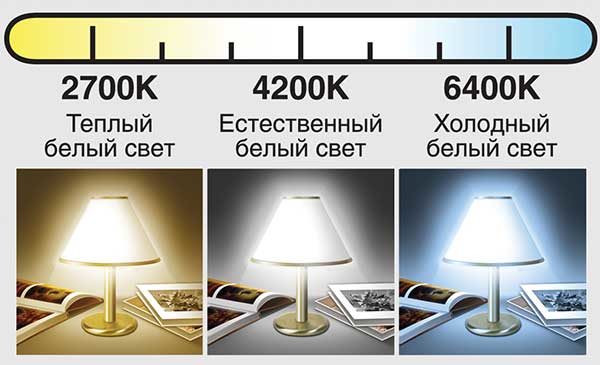
To make it clearer, this parameter indicates what brightness and color shade the emitted light will have.
A 100-watt incandescent lamp has a light temperature of 2800 K, which in the optical range corresponds to warm white light with an orange tint. This temperature is sunlight during dawn and dusk.
The average lifespan of an incandescent lamp is 2000 hours. We will proceed from these parameters in the future. The service life of lamps can be extended by special devices that not only regulate the degree of illumination of rooms, but also save electricity.
Halogen devices
Now let’s talk about the energy-saving lamps themselves and start with halogen lamps. Essentially, this is the same incandescent lamp, but with some modifications. In her flask, in place of vacuum, there is a buffer gas (bromine, iodine vapor).
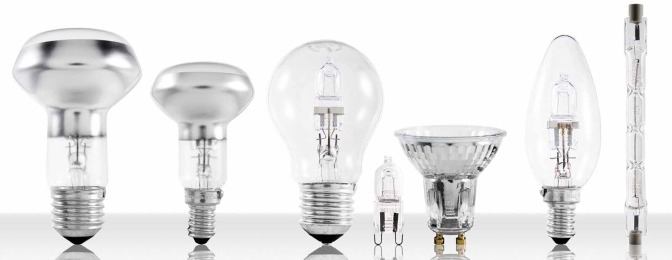
The use of these vapors made it possible to increase the light temperature to 3000 K, and the lamp efficiency is 15-17 lm/W to provide the same 900 lm luminous flux.
Due to its better light output, the halogen element is able to provide the same amount of light as a 75-watt conventional incandescent lamp, but it only requires 55 watts of energy, meaning there are already electricity savings.
In addition, the use of buffer gas increased the lamp life to 4000 hours of operation.
The advantages of halogen elements, in addition to efficiency and increased resource, also include their availability, since they cost not much more than conventional lamps.
They are available with E14 and E27 sockets.
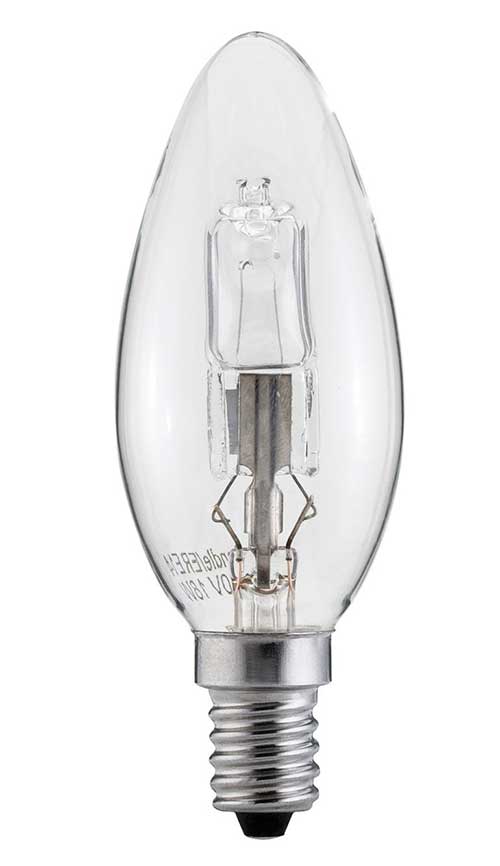
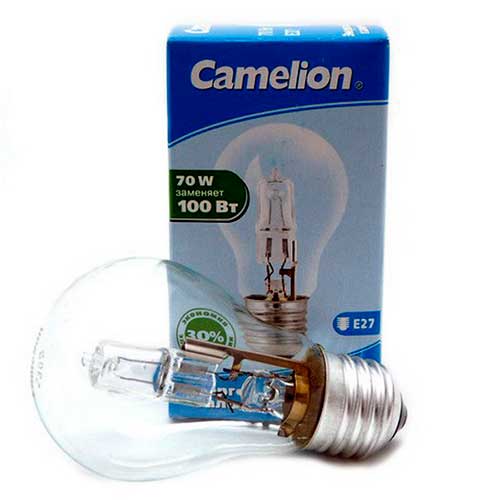
At the same time, they often have smaller dimensions than incandescent lamps, which allows them to be used even in miniature lamps.
The disadvantages of halogen elements are the same as those of conventional incandescent lamps.
Luminescent
These lighting very reliable, safe, immune to voltage surges.
Produced with the most common types of bases. There are elements in the design of which batteries are additionally included, which allows you to use the lamp from a regular network or from a battery in case of power outages.
There are also devices with a remote control.
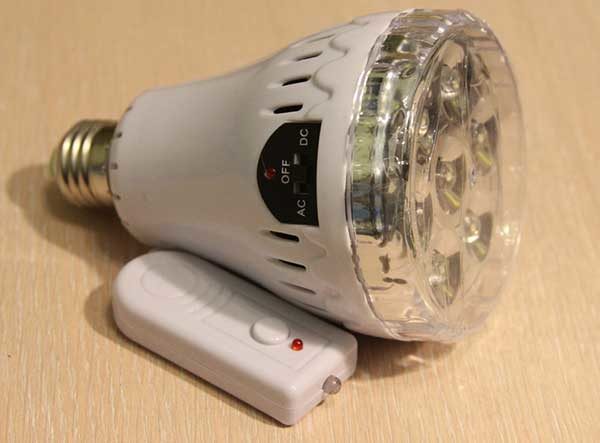
The only drawback of such lighting devices is that they are very high price, approximately twice as high as the cost of luminescent analogues.
Options to select
Now let’s talk about what parameters you need to consider when choosing an energy-saving light bulb. First of all, you need to decide on the type. In this case, you should immediately pay attention to the cost and resource.
Power.
The first selection criterion is the power of the lamps. In this case, it is necessary to take into account the correspondence of the selected elements to those already used at home.
For example, 100-watt incandescent lamps are used everywhere in housing, and the light from them is quite sufficient.
Based on luminous efficiency, we can determine that the same amount of light can be provided by a 70-watt halogen lamp, a 20-watt fluorescent lamp, and a 12-watt LED lamp.
If there is not enough light, then you can choose a more powerful energy-saving element.
In this case, you don’t even need to carry out any calculations; comparative tables are usually printed on the packaging of these lamps, which allows you to quickly and easily select a light bulb with the required power parameter.
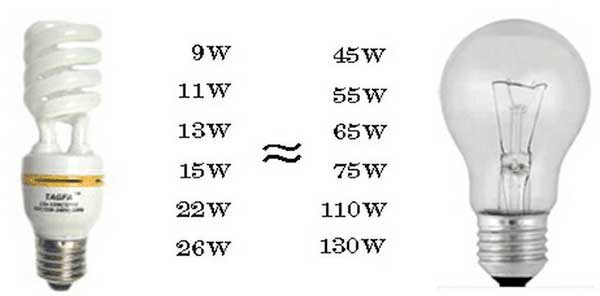
Base type.
The second thing you need to pay attention to is the type of base. Lamp sockets with the designation E27 are suitable for conventional sockets.
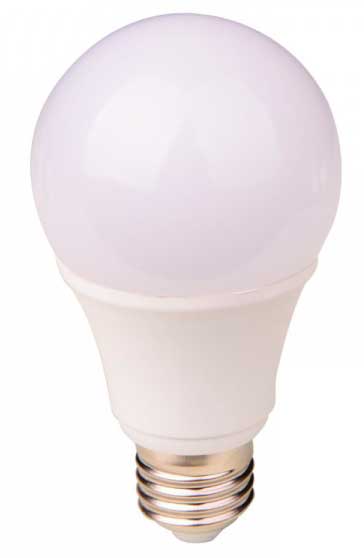
In lamps and sconces, a cartridge for an E14 base is often used.
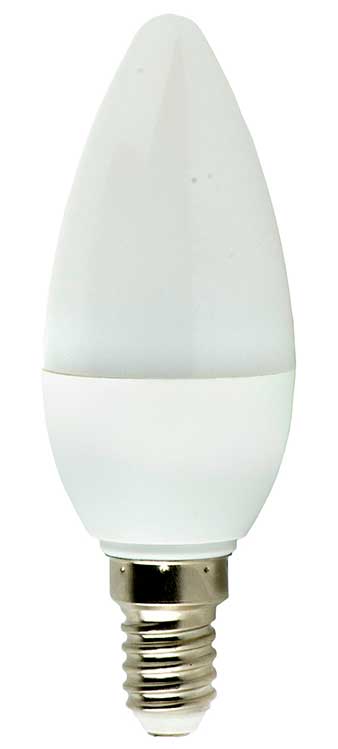
Before going to the store, you should definitely ask what types of bases are needed. But you can do it even simpler - unscrew and take with you the light bulb that will be changed and compare the bases.
Dimensions, shape.
The third selection criterion is shape and size. If there is a lot of space for installation, then you can buy almost any shaped lighting element. In limited installation spaces, you will have to select lamps according to size.
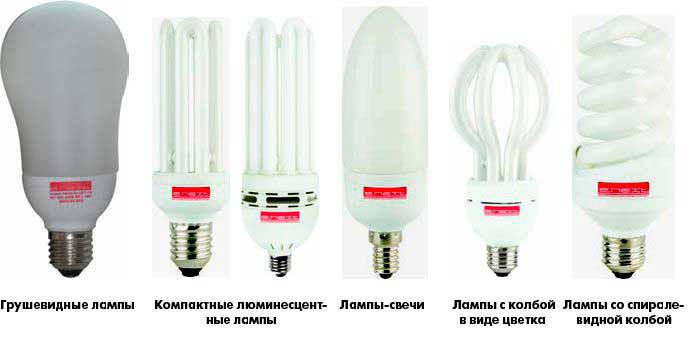 The only thing you need to pay attention to is the LED lamp - they can provide both diffused and directional lighting.
The only thing you need to pay attention to is the LED lamp - they can provide both diffused and directional lighting.
Elements with diffused lighting can be used almost everywhere, but those with directional lighting are better suited for installation in lamps.
Colorful temperature.
And the last parameter, and an important one, is color temperature. Here the selection is made according to the place of use.
So, in bedrooms and living rooms, warm is considered the most optimal. White color different shades. Therefore, in such rooms it is better to use lighting elements with a temperature of 2700-4200 K.
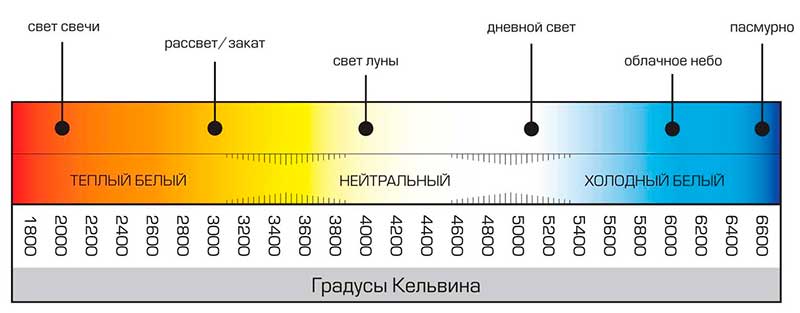 For kitchens, bathrooms, and garages, the best color is cool white, which is provided by light bulbs with a temperature of 5000-6500 K.
For kitchens, bathrooms, and garages, the best color is cool white, which is provided by light bulbs with a temperature of 5000-6500 K.
More suitable for offices daylight, the light temperature of which is 4000-5000 K. Also, such lamps can be used in bathrooms and kitchens.
Other selection criteria energy saving lamps see below.
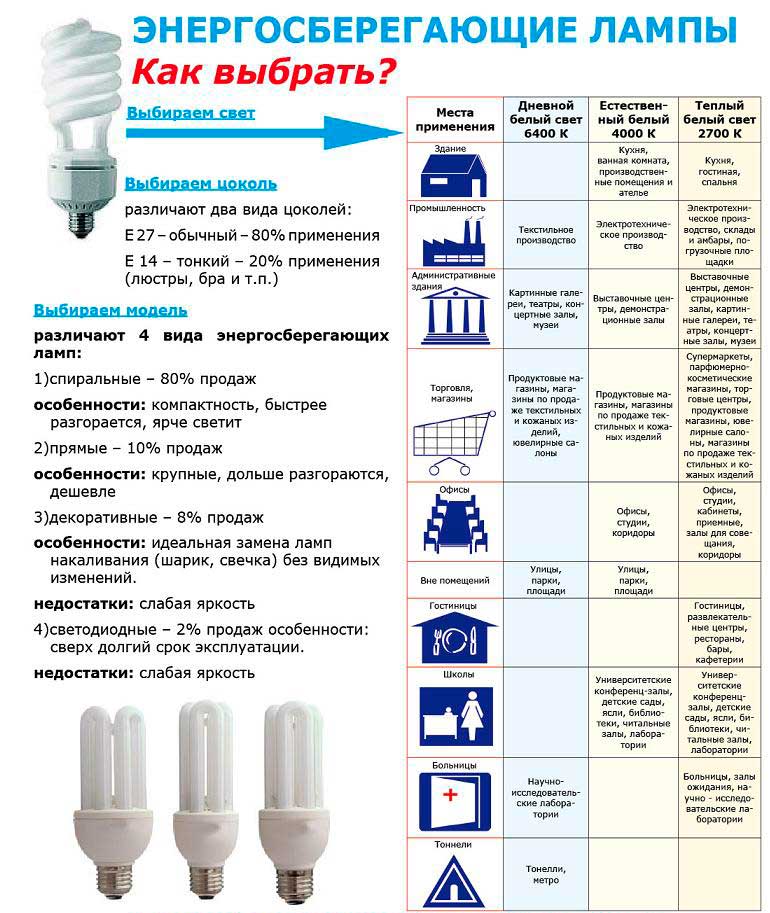
Bottom line
Note that the savings from using “housekeepers” will not be immediate, because the lighting element must first pay for itself using the savings, and this may take quite a lot of time, and this also depends on the intensity of use. And it doesn’t matter whether you use such lighting devices in a private house or in an apartment.
A halogen lamp will pay for itself the fastest, but in the long run the savings from it will be negligible.
The luminescent element can pay for itself after just a year of use, and in the future it will begin to save money. Concerning LED lamps points, then they have the longest payback period, about three years.
In general, only those lighting elements that have a significant resource and can operate without problems for more than two years can bring truly tangible savings.
Finally, let’s say that it is not necessary to immediately replace all the lighting elements in the house with energy-saving ones, because this can result in significant costs.
If you change them gradually, then the expenses will not be so noticeable, and ultimately it will be possible to completely switch to energy-saving lamps.
Good luck to all!
THIS MAY BE INTERESTING:
Incandescent lamps have served us at home for decades. Everyone knows what their shortcomings are; they have already come to terms with them. Only a small part of the energy is converted into them into visible to the eye light, which explains their low coefficient useful action. The rest is dissipated as heat. Economic effect from fluorescent lamps glasses are better, but they are more difficult to use at home due to large sizes. The service life of incandescent light bulbs depends on the frequency of switching on and the supply voltage.
Now energy-saving and LED lamps have appeared, designed to eliminate the main disadvantages of existing light sources. Their efficiency and service life are much higher, and their performance is better than that of the previous generation of lighting devices.
In order to decide which is better to use, energy-saving lamps or LED lamps, we will consider separately their designs, advantages and disadvantages.
So, which light bulbs are better for the home, LED or energy-saving?
Energy-saving lamps
They are also called “compact fluorescent”. That’s how it is: the principle of operation is the same, but the dimensions are smaller. Miniaturization was possible due to the fact that a long lamp was twisted into a spiral or folded several times.
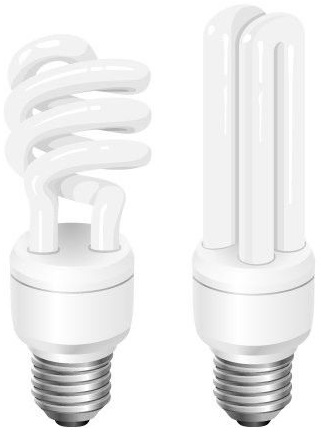
The rest remains unchanged: the tube inside is coated with a phosphor, filled with gas, and at the ends there are two electrodes that are heated during startup. Inside the base there is a control circuit and elements of its power supply.
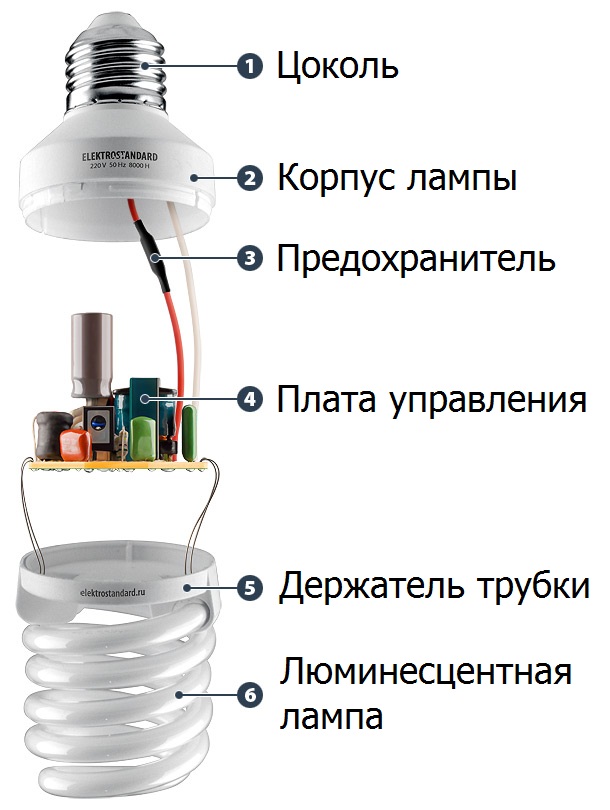
Advantages of energy-saving lamps
With the same luminous flux, energy-saving bulbs consume less power than incandescent bulbs, but LED bulbs are even better in this regard.
The service life of a high-quality energy-saving lamp, under equal conditions, exceeds the service life of an incandescent lamp.
Selecting the shade of light output:
- warm white- corresponds to light from an incandescent lamp (color temperature - 2700 K);
- white— almost never used at home (3300-3500 K);
- cold white- has a faint blue tint (4000-4200 K);
- day- corresponds to the glow of powerful fluorescent lamps (6000-6500 K).
Usually used for home warm light, and for the office - cold.
The price of energy-saving light bulbs is lower than LED ones.
Disadvantages of energy-saving lamps
Energy-saving lamps do not like frequent switching. In this regard, they are not recommended for use in places where lights are often turned on for a short time. For a home, this is a corridor, a bathroom, a toilet. Optimal mode work: turning on the light for at least 5-10 minutes, with breaks of more than 5-6 minutes.
They do not immediately show the full brightness of the glow; for some time they shine dimmer. There are models that turn on with a slight delay.
Energy-saving light bulbs require ventilation. Inside hermetically sealed lamps, their service life is sharply reduced; this is also facilitated by changes in temperature and air humidity. They don't light well in the cold.
Like fluorescent ones, they need to be disposed of, but collection points are very difficult to find. The lamps contain mercury, which, if damaged in the premises of a residential building, must be neutralized.
Not all models meet the requirements for the luminous flux pulsation coefficient. Depending on the control scheme, it varies in within wide limits and for some models it can reach up to 60%. These flickers are not visible, but have a detrimental effect on the human body, causing fatigue and decreased performance. It is impossible to measure the ripple factor at home.
As the phosphor wears out, infrared and ultraviolet radiation.
It is impossible to adjust the brightness of the light with a dimmer. Dimmable versions are available, but adjusting their brightness is not effective.
LED bulbs
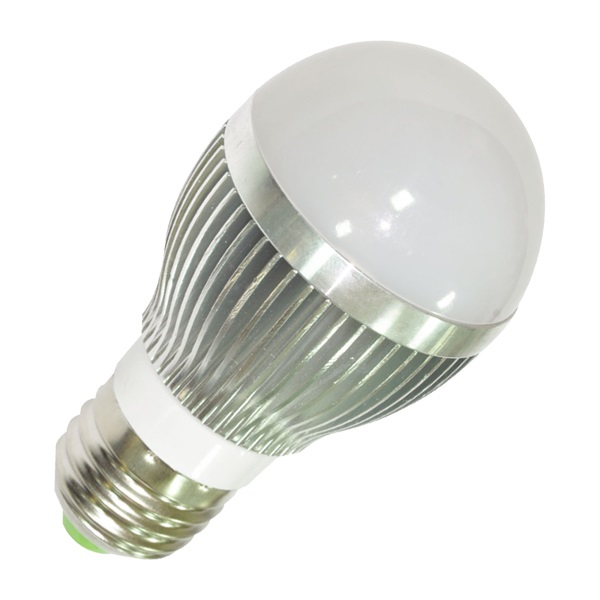
LED lamp with diffuser
Their main element is semiconductor devices - LEDs. The number of them required for operation is installed on the board, and is electrically connected to a power device called a “driver”. The driver includes a rectifier (LEDs operate at DC) and a circuit that reduces the voltage to the required value.
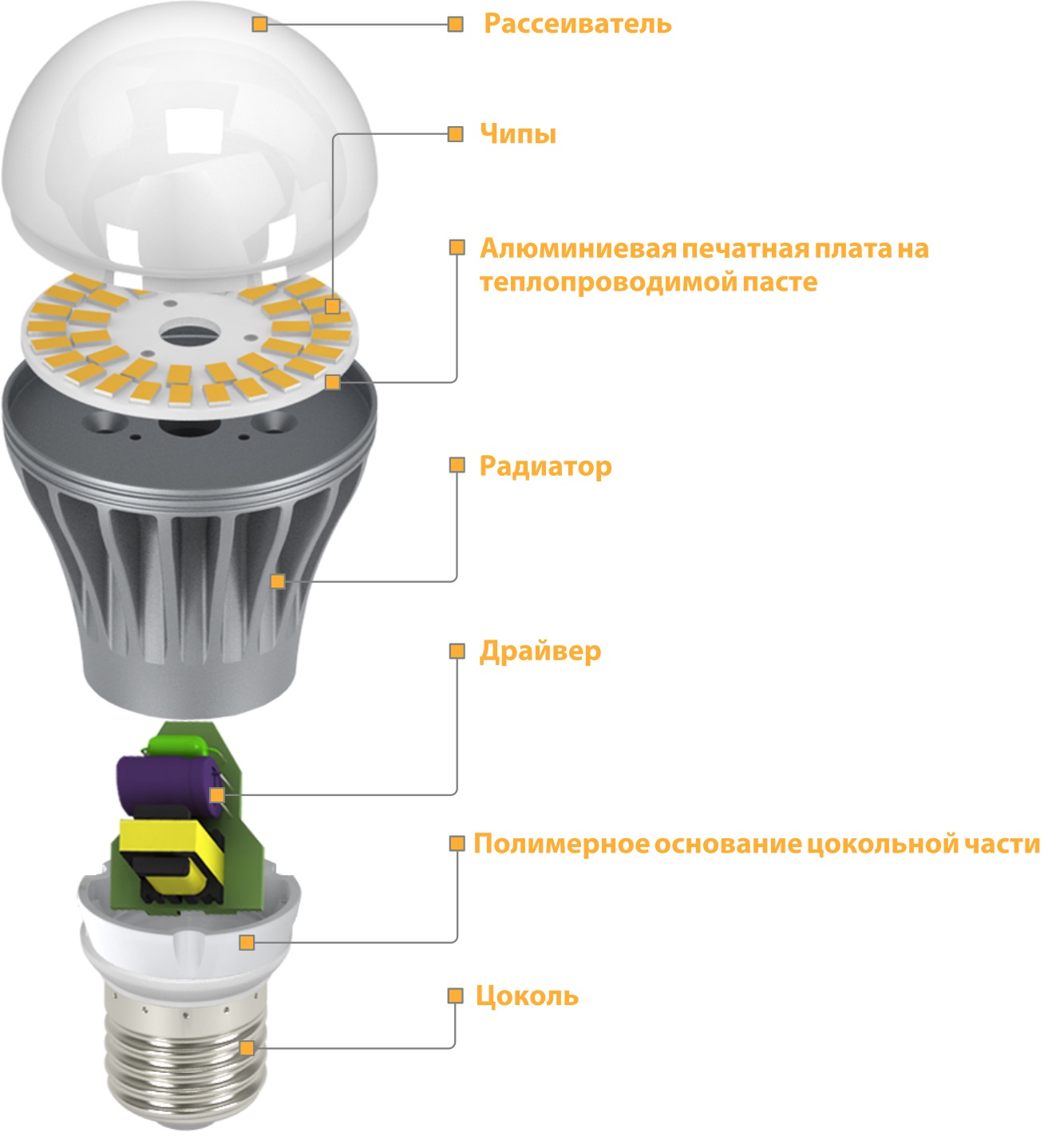
Advantages of LED lamps
The service life is longer than that of energy-saving ones. In this parameter they are second only to metal halides.
In terms of energy savings, LED light bulbs are 2-3 times more effective than energy-saving ones.
Environmentally friendly.
The most compact and durable, not afraid of shocks and vibrations.
They start working instantly and are not afraid of frequent switching.
The range of glow colors is much wider than that of compact fluorescent ones, since LEDs can be manufactured in almost any shade of glow. This expands the possibilities of their application, creating scope for designers.
LED light bulbs better, but not all, but only special models.
Disadvantages of LED lamps
The main drawback is the price, which is 2 - 3 times more than energy-saving lamps.
Looking directly at a running LED results in an effect similar to being blinded by an arc. welding machine. Therefore, light bulbs that do not have diffusers in their design must be used only for ceiling or street lighting.
There are also disadvantages common to energy-saving light bulbs. LEDs also have a ripple coefficient, although less. If new lamps do not have it, then over time, especially after exposure high temperatures, it may appear due to drying electrolytic capacitors in control circuits.
In pursuit of cheaper products, they try to simplify driver designs as much as possible, which leads to reduced reliability and deterioration of performance.
So should you choose LED lamps or energy-saving ones?
Obviously, LED lighting has fewer disadvantages than energy-saving lamps. Does this mean LEDs are better? There is no need to rush to conclusions. When choosing which lamps are better to buy, LED or energy-saving, you need to take into account additional nuances.
Unfortunately, in addition to high-quality lighting devices, the market is flooded with products of dubious quality. When purchasing an expensive product, the buyer invests money, hoping over time to receive economic benefits in the form of energy savings. In fact, he is often disappointed: the light bulb fails after not having served the period stated in the passport. The reason does not necessarily lie in the quality of the purchased product. To extend the service life, you need to take into account the operating features described above in order to understand which LED or energy-saving lamps can be installed in luminaires in specific places.
Not everyone has the opportunity to spend a lot of money on LED lamps, but they can afford energy-saving ones. In some places, the use of incandescent lamps is still quite justified. What kind of lighting devices to install in the lamps is decided on the spot.
Saving these days is not an empty phrase. And when planning a trip to the store for ordinary light bulbs, you should carefully calculate your own costs. Not only immediate costs, but also future costs.
Let's imagine that in normal one-room apartment– 10 light sources (room, kitchen, corridor, bathroom).
How much did we pay yesterday?
If we use outdated incandescent lamps (not on sale since 2015), then in our experimental apartment we will pay about 3,800 rubles for light per year (excluding household appliances, calculation is made according to the Moscow tariff).
One 75 W lamp consumes 0.075 kW of electricity per hour of operation, then the father-in-law, when lit for 3 hours a day, is 82.35 kW per year. Ten lamps – 823.5 kW.
How much are we paying now?
Most Russian apartments already use energy-saving lamps (the so-called CFLs - compact fluorescent lamps), which consume 5 times less electricity. That is, a 15 W CFL gives the same illumination as a 75 W Ilyich light bulb. Using only 10 CFLs instead of the usual 10 incandescent lamps, we will pay 760 rubles per year for light.
ERA Clear LED lamps, or future light bills
Save 90% on lighting? Why not! Introducing ERA Clear LED lamps, or the so-called LED (Light-emitting diode). Savings compared to an incandescent lamp - 10 times! In addition, LEDs do not burn out, unlike long-lasting CFLs and incandescent lamps that burn out very quickly. So there are more of them high price more than justified by the savings they provide!
Colorful temperature
Both energy-saving and LED lamps differ not only in power and luminous flux, but also in color temperature. Surely you have noticed that the lamps produce the usual yellow light, either white or cold blue. When buying ERA lamps, you can immediately see what kind of light the lamp will shine, and not get a surprise by screwing it into your lighting fixtures.
It's very simple - buy a lamp in a package yellow color– you get the usual “sunny” lighting. The blue box will indicate that the light will be cool white. And dark blue indicates cold light with blue.
Cold light preferred in offices and production premises, it puts you in a working mood. It is also mandatory for hospitals and some industries. He is also very popular in southern regions Russia, where people get tired of the bright sun and want a little coolness, at least at the level of sensations.
If speak about technical specifications, then color temperature is measured in Kelvin (K).
ERA LED lamps are available in two versions: 4200K (cool white, blue box) and 2700K (warm white, yellow packaging).
Energy-saving lamps in three color temperatures: 6500K (cool daylight, dark blue packaging), 4200K (bright white light, blue packaging), 2700K (soft yellow light).
Very important aspect in increasing comfort in residential buildings and apartments are provided with high-quality, and, most importantly, energy-saving lighting. At the same time, you need to know about energy saving parameters, the price category of products and their durability in order to decide which lamps are the best.
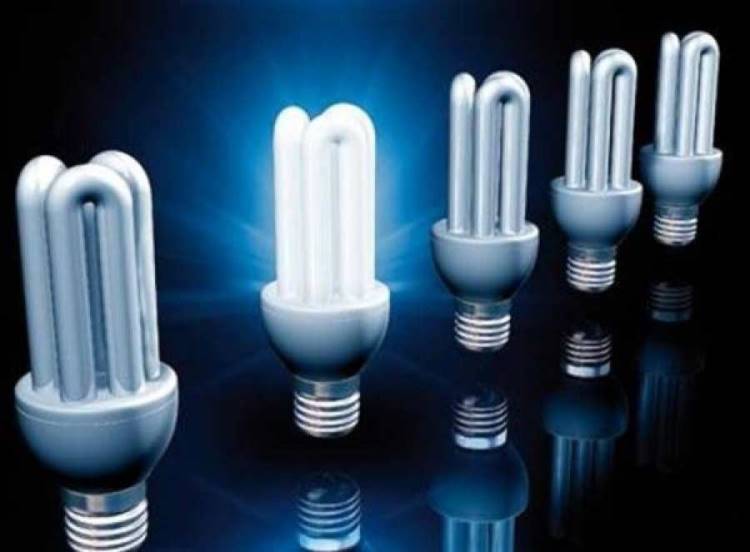
Essentially, they provide a gas-discharge light source. Such light bulbs are very popular not only in residential premises, but also in office buildings and industrial facilities.
The positive feature of these products is that their service life is 15 times longer than the usual incandescent lamps. In addition, they provide an even and stable flow of light. Since the lamps have a low level of heat generation and are quite compact in size, they can be used in lamps that have plastic parts that can be deformed under the influence of excess heat.
Economical fluorescent light bulbs are suitable for standard sockets, which eliminates the additional costs of replacing them and calling electricians. Despite the above, this home lamp has a number of disadvantages:
- It contains mercury vapor. If the product is damaged, the room will be saturated with them in just a few hours.
- High price. Imported models are several times more expensive than their Chinese and domestic counterparts. That's why many people order them online.
- Special disposal method. The country lacks appropriate collection points that handle hazardous waste disposal.
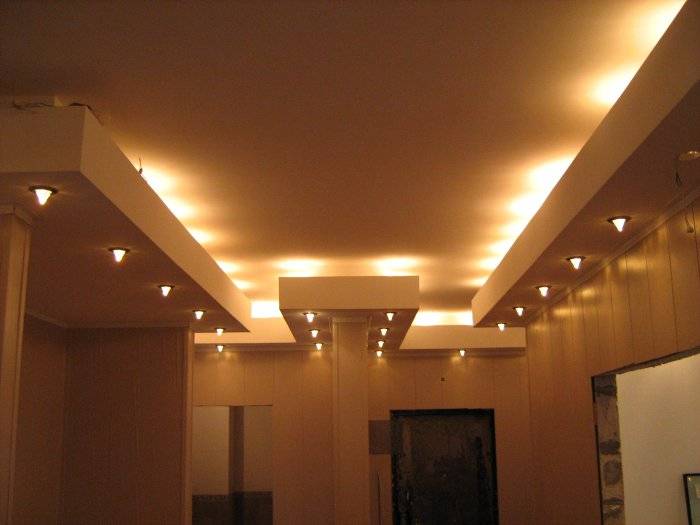
In houses, apartments, cars and other life resources where economical and bright lighting LED lamp is used. Positive quality The lifespan of such a light bulb is lighting, which ranges from one and a half to 10 years, it all depends on the model. It is also resistant to mechanical damage and can function normally at temperatures from -60 to +60°C. Available for any voltage, which eliminates the installation of additional resistors. The light bulb has a clean and uniform light, which is important in lighting design. Its price is quite high, about 300 rubles.
But by visiting qualified online stores, you can buy the product cheaper than in construction hypermarkets.
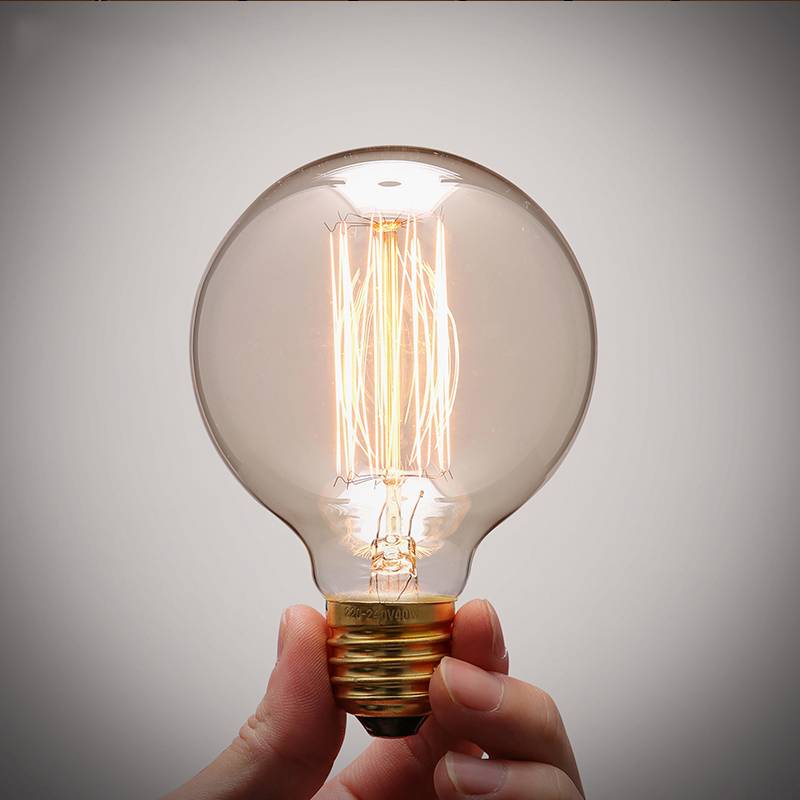
The familiar “Ilyich’s paws” are very popular due to their affordability - up to 25 rubles apiece. What kind of objects are not illuminated by them! By the way, many people who have switched to other types of lighting still have them lying around at home “in reserve.”
The lamp works thanks to a tungsten filament - the filament body. It is this that is the source of light, since it heats up greatly (by several thousand degrees). However, the efficiency of the light bulb is very low - only 5%. The remaining 95% is spent on heating the room. In addition, the service life of such a lamp, at best, is about 1,000 hours. Therefore, its main advantage is considered reasonable price. Moreover, you can buy a light bulb even in the most ordinary grocery store. In other respects, it is much inferior to modern products.
General indicators and types of energy-saving lamps
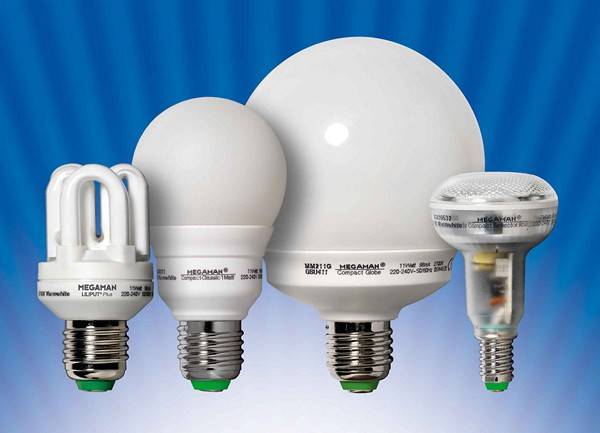
For both home and industrial use, it is very important to have complete and economical lighting; for this reason, you should familiarize yourself with the parameters of the products in more detail.
According to the shape of the base, the light bulb can be:
- For a miniature cartridge (marked E14).
- For standard cartridge – E27.
One of the most important factors What influences the perception of space in a room is the source and color of light. Udachnoe color scheme will make your home warmer, more spacious and comfortable than it actually is.

Lamps are:
- Warm white.
- Cold white.
- Neutral white color.
- Daylight.
They can be either U-shaped or spiral-shaped.
Where is the best place to buy energy-saving lamps?
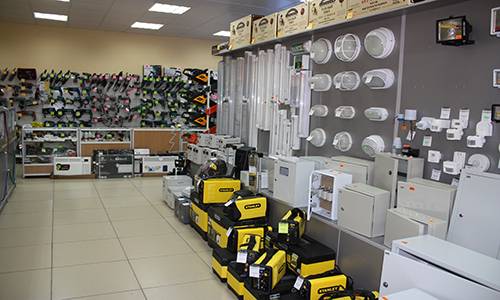
Today, more and more Russians are choosing energy-saving lamps for their homes. But in order to buy them, you need to shell out a considerable amount of money, compared to the cost of an incandescent lamp. Many people go online to search for a product with a more reasonable price. One way or another, you need to take into account: energy-saving light bulbs, compared to the notorious “Ilyich lamps,” use 80% less energy with full and uniform light output, thereby reducing the load on the home electrical network and reducing the likelihood of short circuits, breakdowns, and power outages.
So, in order to buy energy saving light bulb for an apartment, house and other premises, you can contact a hardware store or visit the online market and buy required item in online mode. Last option seems more convenient, since you don’t need to go to different retail outlets in search of the desired model of an economical lamp. A wide range of products is presented on the pages of specialized Internet resources. Under each product, its characteristics, light color, base shape, etc. are described in detail.
In an online store, prices are much lower compared to offline markets. Such a significant difference in approaches to selling goods is a favorable factor for those who own large production facilities. After all, it is more expedient for them to use energy-saving lamps with a long operating period than conventional incandescent lamps, which do not provide adequate illumination. large rooms and burn out after a few months. Therefore, when shopping online, you not only purchase economical lamps at wholesale prices, but also significantly save personal finances.
The best news for car owners
The effect that appears immediately after attaching the device allows you to save on fuel consumption by up to 20% and eliminates carbon deposits inside the power unit, and also allows you to increase engine power by 5 hp. With.
We pay very little attention to the familiar things that surround us. Meanwhile, they are often the determining factors in creating the impression of the interior. Surprisingly, even simple light bulbs can affect our mood and well-being. Pavel Gorchakov, Philips expert " Lighting solutions", told Lady Mail.Ru about the main nuances when choosing lamps and shared four important parameters, which you should pay attention to when purchasing.
Incandescent lamp- the most common option today and also the oldest technology. It is distinguished by its low price and the familiar warm yellow light. However, it is the least energy efficient and will only last about a year (sometimes less). An incandescent lamp “gives” to us no more than 10-15% of the energy consumed in the form of light, and the remaining 90-85% of the energy is converted into heat. In other words, it warms rather than shines.
Halogen lamp- the same incandescent lamp with a bulb filled with gas. It will last approximately two to three years, but it has a serious drawback - the lamp heats the surrounding space quite strongly, which significantly reduces the range of its use.
Energy saving (fluorescent) lamp Lives up to its name and actually reduces lighting costs by up to 80%, but requires special disposal because it contains mercury.
The most innovative and possessing the largest number advantages compared to other lamps - LED lamp. It has the longest service life - up to 25 thousand, high energy efficiency - it can save up to 85% of lighting costs - and the absence of thermal, IR and UV radiation. It does not need to be disposed of in a special way. Also, some types of LED lamps have the ability to dim (adjust the brightness), which will allow you to choose the ideal level of illumination for any situation. In addition, LEDs light up instantly, unlike fluorescent lamps, which take 2-4 seconds, which irritates many.
Today you can buy an LED lamp for a price of 200 rubles. At the same time, technology does not stand still, the scale of production is growing, due to which the price is becoming lower every year.
The main parameters in choosing light bulbs:
amount of power consumption (watt). Incandescent lamps are standard 40-60 W. The power of LED lamps varies from 1 to 14 W. However, it is important to understand that the indicator of electricity consumption does not characterize the luminous flux, which determines the brightness of the lamp. So a 7W LED bulb will shine as brightly as a 60W incandescent bulb.
Colorful temperature. There are several standard configurations: 2700 K (incandescent light), 4000 K (daylight, neutral) and 6500 K (cold). In the living room or bedroom, lamps that emit warm light are usually used to create a cozy atmosphere. Cold light, on the contrary, is preferable in an office or sports room, as it helps to concentrate and gives a boost of vivacity and energy. Color temperature has no effect on the amount of light or its quality, so the choice depends only on your preferences.
color rendering index (Ra)- characterizes the correct perception of the color of objects when illuminated by a lamp, which, if chosen incorrectly, can be a fatal factor for your interior. Manufacturers of quality products indicate it on the lamp packaging. For example, for LED lamps Ra should be 80.
luminous flux stability coefficient. This coefficient states the service life during which the brightness of the luminous flux will decrease by no more than 30% of the nominal value. This is especially true for LEDs, because they do not burn out at once, but gradually fade away. For example, an LED lamp has a service life of 25 thousand hours (approximately 25 years), and the luminous flux is approximately 1000 Lumens. After the specified period, the luminous flux must be at least 70% of the nominal, that is, at least 700 Lumens.
Unfortunately, at the moment there are no strict standards in Russian legislation, so on the shelves today we see a huge number of LED lamps from unscrupulous manufacturers. Therefore, the best decision when choosing a lamp is to focus on famous brands, whose product quality meets the highest international standards.
From the right choice A lot depends on the lamp. First of all, high-quality energy-efficient lamps can significantly reduce lighting costs. Today, LEDs already save up to 85% of lighting costs. Also, the light of LEDs is as close to natural as possible. This allows us to talk about a beneficial effect on human health and well-being. In addition, the lamp can serve as a decorative element, and its light, depending on the choice of color temperature, will give a feeling of warmth and comfort or, conversely, will invigorate and tone.




